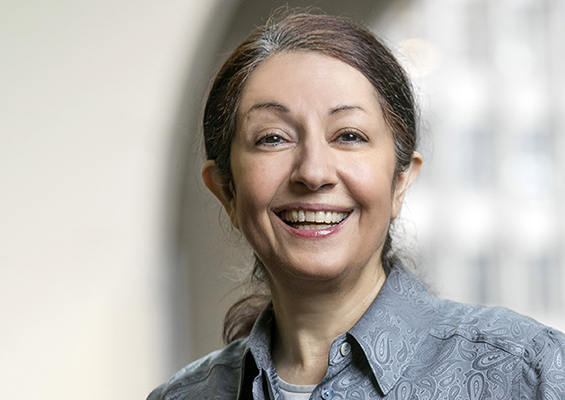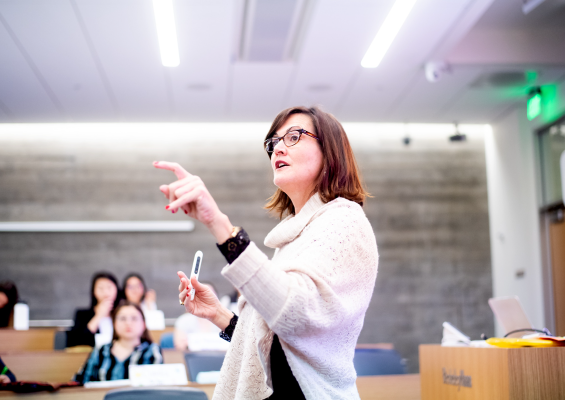Homa Bahrami arrived in the Bay Area as a postdoc, with a solid body of field research, having studied organizational systems of some of Europe’s largest multinational companies. These were the bedrock of the industrial age, largely built for stability and predictability, where change happened incrementally and periodically. The start-up culture of Silicon Valley turned all those assumptions “upside down” and led to her co-authorship with Stuart Evans, of Super-Flexibility for Knowledge Enterprises. The book and her class, Creating Effective Organizations in the Berkeley MBA for Executives program, as well as her executive courses on Accelerating Change Readiness and Agility focus on practical approaches for strategizing, organizing, and leading knowledge workers in today’s turbulent and unpredictable world.
The entire world had a lesson in flexibility during the Covid-19 pandemic. How did you approach that in your teaching?
The pandemic is the biggest inflection point I have lived through. So much changed all at once. I taught a class on campus on March 11, 2020, and the following Monday, I found myself teaching online.
Although I had already taught several executive courses online, redesigning a semester-length course that was originally intended for the classroom took a lot of exploration and experimentation. I distilled and synthesized the core content of my courses and experimented with online opportunities for group discussion. These included polls, breakouts, and different forms of experience sharing, approaches that prompt self-reflection and group conversation.
I also had to adjust my own expectations. I love informal conversations and the give-and-take of the classroom. I love the whiteboard, and opportunities to engage in less orchestrated discussions. There is less leeway for improvisation and detours online. I also realized that we all had to show up for online classes with a lot of energy and razor-sharp focus, primed and ready to engage. Unlike passively watching a movie, online teaching has to be very active and touch each individual in a personal way.
How would you describe your teaching style?
I love teaching and have three guiding principles: First, bridge the gap between knowing and doing so students know how to put their learnings into practice. Second, balance “push” and “pull”—in other words, share research-based tools and practices, but also help the students reflect on their own experiences. Finally, expose them to diverse views and experiences by inviting guest speakers from different backgrounds.
I spend a lot of time thinking about who to invite and how the guests’ experiences can help us tune in to “live case studies.” For example, one of my recent guests was Jay Vijayan, the founder of Tekion, a tech unicorn. He shared how he adapted the disruptive ERP (enterprise resource planning) expertise he gained as the first CIO at Tesla to create a transformative system for car dealerships at Tekion. Another guest was InaMarie Johnson, chief People & Diversity Officer at Zendesk. She discussed how Zendesk is trying to set up the organizational infrastructure for hyper-growth, and develop an inclusive culture on a global basis.
What is a favorite classroom exercise?
Over the years I have developed a number of proprietary tools based on my field research and advisory work in Silicon Valley. One of my favorites explores an individual’s “adaptive DNA.” The concept describes an individual’s instinctive capacity to deal with change and uncertainty. We look at five distinctive adaptive capabilities: robustness, resilience, agility, hedging, and versatility.
The diagnostic enables my students to hold up a mirror and think about their unique adaptive capabilities. I love to see their reactions when they get their survey results. It prompts them to reflect and personalizes the learning journey.
What are the rewards of teaching Executive MBA students?
A mentor once used an interesting metaphor. He said executive students have an extensive range of clothes—in other words their diverse and unique experiences—it is my job to give them coat hangers so they can organize and make sense of these experiences. “Coat hangers” refers to organizing principles, concepts, practices, tools, and frameworks. By combining the best of both, we forge a learning partnership, engage in robust debates, and learn together. It reflects Haas’ Student Always Defining Principle.
What do you hope your students will take away from your classes?
Three things: First is the ability to reflect on their own experiences and make sense of them. I hope they become more self-aware and develop a greater understanding of their organizations. Second, I give them a practical toolbox so they can address their daily challenges and opportunities, with flexibility and agility. Finally, I hope the course experience instills Confidence Without Attitude and helps them lead and succeed in today’s fluid world.
The expertise and insight your professors bring helps deepen and enhance your MBA journey. By selecting a top school with top-notch professors, you maximize your experience.

Read more from the Take 5 with a professor series:
- Cameron Anderson can prove that being a jerk is not a good career strategy
- Laura Kray reveals the skill MBAs want in their core curriculum
- Kellie McElhaney talks equity fluency, courage, and vulnerability
- Lucas Davis shares hardest economic concept for MBA students to grasp
- Jenny Chatman gives three benchmarks of an effective organizational culture
- Jennifer Cohen talks equitable and inclusive leadership
- Clark Kellogg shares how he teaches design thinking, creativity, and innovation
- Dave Rochlin talks flipping the classroom: MBAs learn by doing
- Maura O'Neill says narrow-mindedness is the enemy of innovation
- Bill Pearce says most important trait of a successful marketer is empathy








